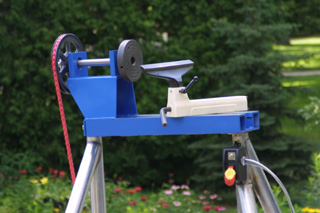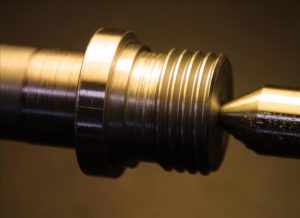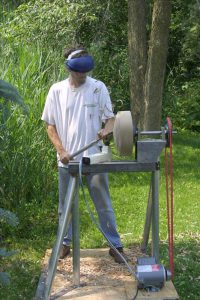Includes affiliate links that help offset our expenses at no cost to you.

I love my JET 1462 Lathe but it’s in the basement, and unless it’s raining or snowing I really prefer to spend my time outside. I’ve dreamed of being able to turn bowls outdoors in the garden, to enjoy the nice weather and to create bushels of wood shavings right where they will be used on the garden paths rather than spraying shavings all over my basement shop. But my Jet lathe weighs about 500 pounds and it’s just not practical to move it anywhere. So I designed and built this portable lathe that is easy to move around, yet still has the capacity to handle big bowl blanks up to 16” in diameter.
Design
Firstly I wanted it to be portable, with no piece weighing over 50 pounds so I can easily carry it out to where I want to work. The lathe body and the base ended up weighing almost exactly 50 pounds each, with the motor weighing about 35 pounds and the legs around 20. It also had to be quick to set up and take down, and I can set it up in under 10 minutes including the time to carry each piece out to where I’m going to work.
I designed the lathe primarily for turning bowls so it has a short bed, just long enough to handle good-sized bowl blanks and to let me use a tailstock for holding bowls against a jamb chuck for turning the bottom. It could also handle spindles up to about 10” long but I didn’t make it for spindle work. There are plenty of commercially-available mini lathes that work fine for spindles and are easy to transport, but you won’t find many 16” bowl lathes that you can easily carry around.
I considered making it bigger, perhaps to handle blanks up to 20” in diameter, but I decided to make it with the same geometry as my 16” Jet lathe so that I can use the same tool rest and tailstock and avoid the expense and time of making them. Having a 16” capacity lets me make finished bowls up to about 14” diameter which is a good practical size, and it would have been difficult to make it heavy enough to swing bigger pieces of wood yet still easily portable.

I made the spindle threads the same as on my Jet lathe so I can use the same faceplate and chuck. I decided to go with a solid spindle rather than trying to bore a Morse taper, which made the spindle construction much simpler. That means I can’t use a drive center in the spindle but I don’t need one for bowl making anyway (although I could easily make a thread-on drive center if I ever decide I need one). I also can’t use a vacuum chuck unless I bore a hole through the spindle but at this point I don’t have any plans to do that since I don’t have a vacuum chuck. Most of the time I make green-turned bowls for which I don’t even need the tailstock, just a faceplate and a scroll chuck. When turning outdoors, the fewer accessories I need the better.
In order to make a lathe stable while swinging a big out-of-balance piece of wood one wants it to be heavy, but of course that’s not good for portability. Therefore I made the base of the lathe a platform that I can stand on, to use my own body weight to help stabilize the lathe. At the moment that adds about 155 pounds to the base, but as I get older the lathe will probably get more stable. 🙂 I made the bed the same height (above the platform) as my Jet lathe so that my posture is the same when I’m standing at either lathe.
To keep the drive simple I went with a three-step pulley (2-3-4”) on the motor and an 8.5” sheave on the spindle. With a 1725 RPM motor this gives me three speeds of about 400, 600 and 800 RPM which I find is a good range for bowl making. I start turning the blank at 400 RPM to get it reasonably balanced, do most of my turning at 600, and sand at 800. The 1 HP motor has plenty of power because unlike my variable-speed Jet lathe, the motor runs at full speed all the time. I mounted the motor down on the base to help stabilize the lathe, and I used a link belt to minimize vibration and to make it easy to get exactly the length I needed. It’s also long enough that I can shift it to any of the 3 steps on the motor pulley without much misalignment, and because the motor is on a hinged platform I can change speeds in about 30 seconds. I didn’t enclose the belt so it is a potential hazard, but I figure it’s less hazardous than the big piece of wood turning right in front of me. The most dangerous part of any tool is, of course, the operator.

Since this is meant to be used outdoors I bought a 25-foot, 12-gauge extension cord to use as the power cord. By wiring this to an outlet box on the motor base, I also have two outlets to provide power for a sharpener and if necessary, a fan to blow away dust while sanding. I’ve been using it with an additional 85-foot, 12-gauge extension cord and it seems to work fine. I haven’t yet measured the voltage at the motor while it’s under load but it doesn’t seem to be getting unduly hot so I expect that the voltage drop is minimal.